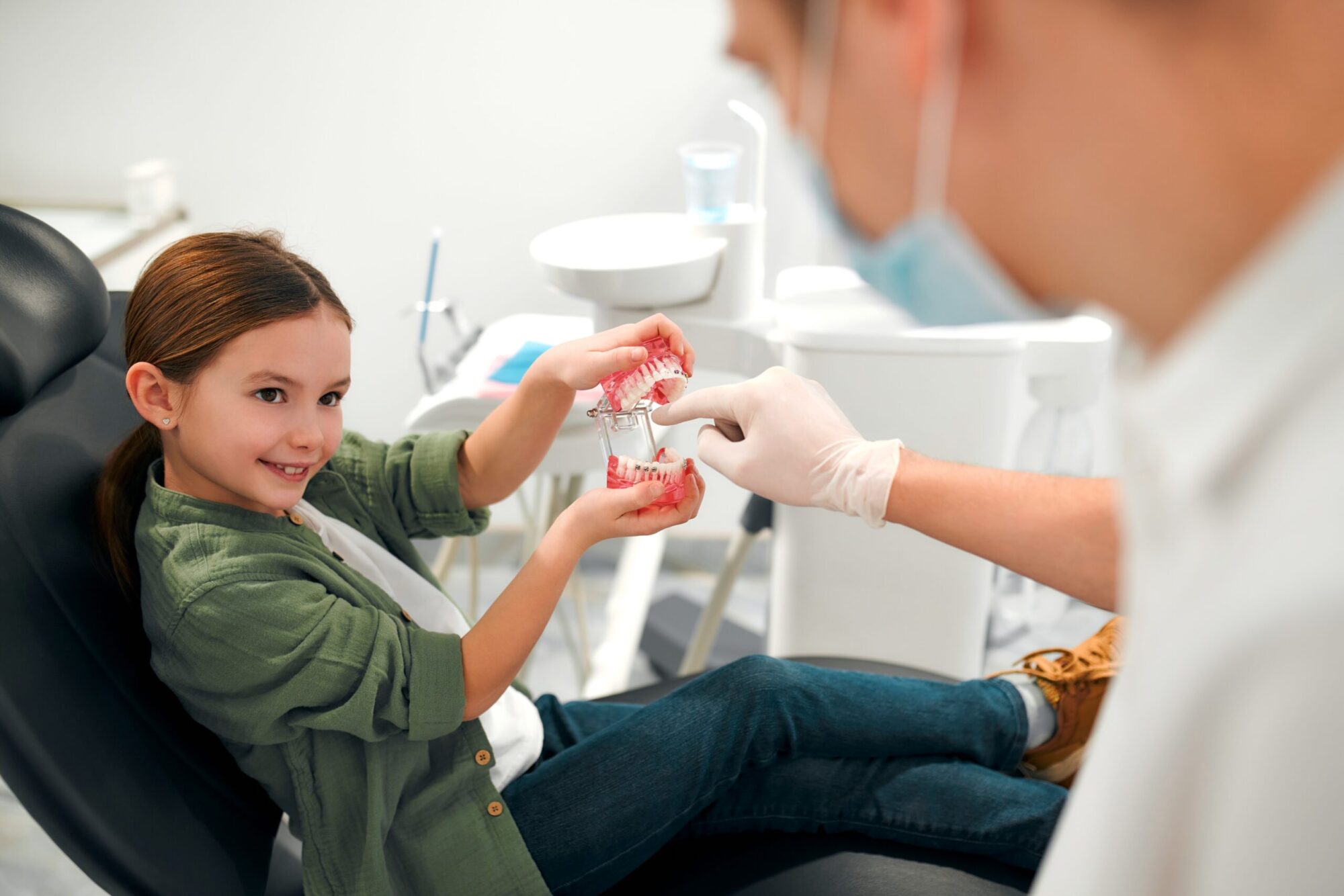The American Association of Orthodontists recommends children see the orthodontist for the first time at age seven. At Hawley Orthodontics, this first visit often results in Dr. Hawley recommending periodic check-ins as your child grows to make sure oral development is on track. Then if needed, he’ll let you know when your child reaches the best age for braces.
But what happens when an early visit reveals that your child needs Phase 1 orthodontic treatment? Are early braces for kids or other early intervention treatments possible when your child has a few baby teeth mixed in with their adult teeth?
You’ll be glad to know that getting early orthodontic treatment with baby teeth still present is not uncommon. If an orthodontist for kids like Dr. Hawley has suggested braces or other Phase 1 treatment for your young child’s teeth, the purpose is to guide the growth and development of your child’s jaws and teeth at a time that’s right for them.
To help you understand early orthodontic treatment, your orthodontist in Papillion, NE wants to share seven helpful things to know:
-
Early Intervention Moves Teeth & Jaws When They Respond More Easily
The goal of early orthodontic treatment is to address orthodontic issues in younger kids during a time when teeth and jaws respond quicker and with less discomfort. Younger kids’ teeth and jaws are still growing so they’re more receptive to movement. With braces or an appliance like an expander on a mix of baby and adult teeth, the orthodontist can guide teeth and jaws into proper alignment much easier than in the teen and adult years when it’s all permanent teeth.
Take, for example, a young child’s upper jaw. It’s still in two halves and will expand easier to make room for crowding adult teeth. Conversely, the upper jaw in adulthood is fused together and it takes more time, effort, and discomfort to expand the palate.
-
Braces when your child has both baby teeth and adult teeth make later orthodontics easier and faster
Phase I braces at a time when your child still has a few primary teeth can make braces treatment, later on, easier and shorter. Why? Because by age seven, your child’s jaw shape is pretty much established, an experienced orthodontist like Dr. Hawley can see how your child’s teeth and jaws will grow; Phase 1 orthodontic treatment can begin correcting future issues before they get worse. Appliances or braces for young kids do a lot of the heavy lifting when it comes to fixing severe issues like crowding or crooked teeth, or jaw alignment issues like crossbites, severe overbites, or underbites.
In other words, Phase 1 braces alleviate the severity of braces later on. Some of our young patients don’t even need braces or Invisalign by the time they’re in their teens because early braces corrected their teeth and jaw problems.
-
Braces on baby teeth can help with fixing unhelpful oral habits
Another reason for Phase 1 braces is to help discourage habits like prolonged thumb sucking or pacifier use. When these infant habits carry on into the toddler and early elementary school years, they can negatively impact dental development by causing protruding front teeth, crossbites, and open bites. Orthodontists might recommend braces on both baby and adult teeth or other Phase 1 orthodontics to correct misaligned teeth and bites as well as discourage the prolonged baby habits that caused them.
-
There are different kinds of early braces for kids
Orthodontics for kids comes in different types, such as braces, removable appliances, or expanders. At Hawley Orthodontics, we offer self-ligating braces with metal or ceramic brackets for Phase 1 braces. Dr. Hawley’s custom plan for your little one’s braces depends on your child’s needs, the severity or complexity of their orthodontics issues, and your preferences.
We should mention that braces on baby and adult teeth together are a little different than braces solely on adult teeth. Early braces for kids are called “limited braces” and we only put brackets on teeth that need shifting, not on all of them.
-
Braces for young kids have a shorter treatment time
Early orthodontic treatment typically takes less time compared to comprehensive orthodontic treatment in the teenage years. In our experience as an orthodontist for kids, we’ve found that the typical range is 6-14 months and depends on the complexity of your child’s case.
-
Follow-up care is important for staying on track
Regular appointments with your orthodontist in Papillion are necessary throughout your child’s early orthodontic treatment. Adjustments, check-ups, and monitoring of your child’s progress are important to ensure that your child’s braces are working effectively and any concerns are addressed early. At Hawley Orthodontics, coming to our Omaha area office is a fun and comfortable experience for kids and their adults; we have a kid-friendly atmosphere that ensures your child is at ease as soon as they walk through the door.
-
Oral hygiene is key
Thorough oral hygiene is vital during Phase 1 orthodontic treatment. Parents and children need to ensure that braces, wires, teeth, and gums are kept clean every day. Twice a day brushing, daily flossing, and using any additional cleaning tools or techniques recommended by Dr. Hawley all help in keeping tooth decay and cavities at bay. Tooth decay and cavities can interrupt braces treatment, sometimes even prolonging it if braces need to come off for fillings or other oral health treatments.
Early Orthodontic Treatment with Your Papillion Orthodontist
Well, hopefully you now know how to answer, “Can you get braces on baby teeth and adult teeth together?” Plus, we’ve talked about a few things to consider around early orthodontic treatment.
If you have more questions, schedule a complimentary early orthodontic appointment with the team at Hawley Orthodontics to get your questions answered. We’re here to help your child on their journey to a straighter, healthier, happier smile.
